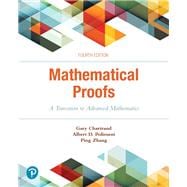For courses in Transition to Advanced Mathematics or Introduction to Proof.
Meticulously crafted, student-friendly text that helps build mathematical maturity
Mathematical Proofs: A Transition to Advanced Mathematics, 4th Edition introduces students to proof techniques, analyzing proofs, and writing proofs of their own that are not only mathematically correct but clearly written. Written in a student-friendly manner, it provides a solid introduction to such topics as relations, functions, and cardinalities of sets, as well as optional excursions into fields such as number theory, combinatorics, and calculus. The exercises receive consistent praise from users for their thoughtfulness and creativity. They help students progress from understanding and analyzing proofs and techniques to producing well-constructed proofs independently. This book is also an excellent reference for students to use in future courses when writing or reading proofs.
0134746759 / 9780134746753 Chartrand/Polimeni/Zhang, Mathematical Proofs: A Transition to Advanced Mathematics, 4/e








